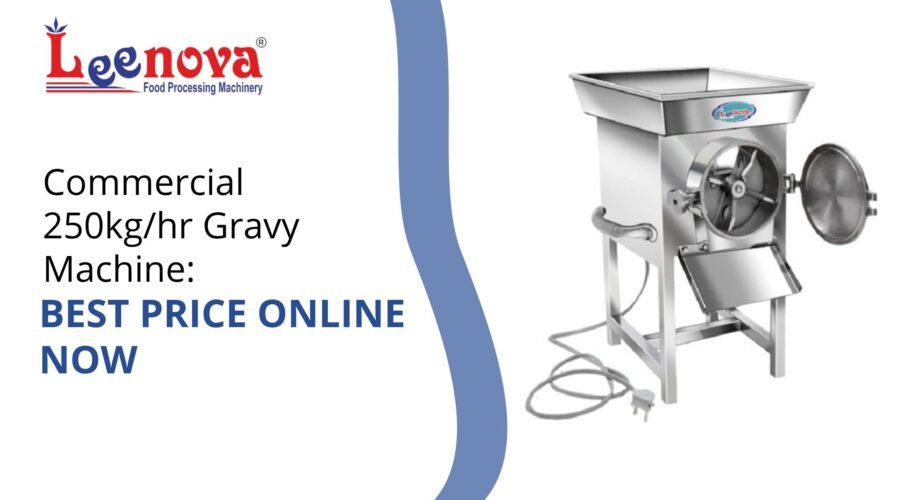Large-scale catering and banquet operations grind over 200 kg of ingredients daily, yet most rely on 2-3 HP machines built for restaurant volumes. The result: overheated motors, inconsistent batches, and prep delays that ripple through service. A 5 HP stainless steel gravy machine rated for 250 kg/hr eliminates this bottleneck, processing wedding-scale volumes without breaking stride. This guide covers specifications, construction advantages, operational benefits, and maintenance protocols for high-capacity commercial grinding.
Technical Specifications and Capacity
Motor Power and Voltage Configuration
A 5 HP three-phase motor delivers 3.7 kW of continuous power, handling dense ingredients like boiled chickpeas, coconut chutneys, and thick onion pastes that stall lower-wattage units. Three-phase wiring (415V) distributes electrical load evenly, preventing voltage drops during peak grinding. Single-phase alternatives exist but overheat during extended runs—inadequate for operations running 6-8 hour shifts.
Grinding Capacity Breakdown
The 250 kg/hr rating assumes wet ingredients with moderate water content. Watery items like tomatoes hit 280-300 kg/hr; dense loads like ginger-garlic paste drop to 220-240 kg/hr. Chamber dimensions typically measure 9-10 inches in diameter and 4-5 inches deep, holding 3-4 kg per batch. A complete grinding cycle takes 45-60 seconds, translating to 50-60 batches hourly under optimal conditions.
Physical Dimensions and Installation
Machines weigh 80-110 kg depending on motor mounting and housing thickness. Footprint spans 24″x18″x36″ (L×W×H), fitting under standard commercial counter heights. Floor-mounted rubber pads absorb vibration. Electrical draw peaks at 20-25 amps during startup, requiring dedicated circuit breakers rated 32A minimum.
Construction and Material Quality
Food-Grade Stainless Steel Architecture
SS304 grade forms the grinding chamber, blades, and outer casing. This austenitic steel contains 18% chromium and 8% nickel—resistant to chloride corrosion from salt-heavy ingredients. Unlike mild steel machines painted food-safe, SS304 eliminates coating flake-off risks. Polished finishes achieve 180-grit smoothness, preventing ingredient adhesion and bacterial colonization.
Welded Seams and Leak Prevention
TIG (Tungsten Inert Gas) welding creates hermetic joints between chamber sections. Traditional bolt-assembled units trap moisture in crevices, breeding mold. Welded designs rinse clean in under five minutes post-shift. Sealed motor housings protect electrical components from splashes—critical when grinding high-moisture items like palak or mint.
Performance and Efficiency
High-speed blades rotate at 2880 RPM, double the speed of 2 HP consumer models. The velocity generates shear forces that emulsify ingredients rather than chop them, producing restaurant-quality smooth textures. A 10 kg batch of boiled onions reaches uniform consistency in 40 seconds versus three minutes manual grinding—an 78% time reduction.
Energy consumption averages 3-3.5 kW per hour under full load. That translates to ₹25-30 hourly at commercial tariff rates (₹8/unit). Processing 200 kg costs ₹20-24 in electricity—negligible against labor savings. Overload cut-offs disengage motors when jamming occurs, preventing winding damage that accounts for 60% of service claims.
Applications in Commercial Kitchens
High-Volume Catering and Banquets
Wedding caterers preparing for 1,000+ guests require 50-80 kg of gravy base. A 5 HP machine completes this in 20-25 minutes, leaving hours for curry assembly and finishing. Festival kitchens feeding 5,000-10,000 people run multiple batches without cooldown intervals—impossible with undersized equipment.
Institutional Food Production
Corporate canteens, hospital kitchens, and university dining halls operate on fixed schedules. Late prep disrupts meal service. The 250 kg/hr throughput accommodates tight timelines, grinding ingredients for 2,000-3,000 meals in a single morning shift. Consistency matters here—standardized texture ensures uniform cooking times across industrial-sized vessels.
Food Processing and Packaging Units
Manufacturers bottling gravies, pastes, and chutneys need industrial reliability. This machine runs 8-10 hours daily, processing ingredients for retail distribution. The stainless steel construction meets FSSAI (Food Safety and Standards Authority of India) compliance, necessary for commercial licensing.
Hygiene and Maintenance
Disassembly and Cleaning Protocol
Four wing nuts release the grinding chamber from the motor assembly. No tools required—operators remove components at shift end, rinsing under high-pressure spray. Blade units unscrew for separate sanitization. Daily cleaning takes 8-10 minutes versus 20-25 for bolt-on designs. Quarterly deep cleans involve descaling agents for mineral deposit removal.
Blade Lifespan and Replacement
Hardened steel blades endure 2,500-3,000 operating hours before dulling. At 8 hours daily, that’s 10-12 months. Indicators include longer grinding times, fibrous residue in output, and motor strain (audible pitch changes). Replacement blade sets cost ₹3,500-₹5,000. Some operators sharpen blades twice before replacing, extending lifespan to 18 months.
Comparison with Lower Capacity Machines
A 3 HP machine rated for 100-120 kg/hr costs ₹22,000-₹28,000. The 5 HP unit ranges ₹38,000-₹48,000—a ₹16,000-₹20,000 premium. However, running two 3 HP machines to match output increases floor space, electrical infrastructure, and labor supervision costs. The single larger unit proves more economical beyond 150 kg daily volumes.
Smaller machines overheat during continuous operation, requiring 15-minute cooldowns every hour. This idle time compounds—over an 8-hour shift, downtime reaches 90-120 minutes. The 5 HP motor dissipates heat efficiently through larger surface area, maintaining operational tempo without pauses.
Frequently Asked Questions
Q: Can this machine grind dry spices or grains?
A: No. Gravy machines handle wet ingredients only. Dry grinding generates excessive friction heat, damaging motor bearings and warping chambers. Use dedicated pulverizers for dry applications.
Q: What’s the difference between single-phase and three-phase motors?
A: Single-phase motors (220-240V) suit small restaurants with standard connections but overheat during extended use. Three-phase motors (415V) distribute load across three wires, running cooler and more efficiently—essential for commercial operations exceeding 4 hours daily.
Q: How much prep space does installation require?
A: Allow 3 feet clearance on the front for ingredient loading and 2 feet on sides for heat dissipation. Total footprint including operator space: 6’x5′. Ensure floor load capacity handles 150 kg (machine + full hopper).
Q: What causes most breakdowns?
A: Overloading the chamber (exceeding 4 kg per batch) strains motors. Grinding fibrous items like raw sugarcane jams blades. Skipping daily cleaning allows dried residue to harden, increasing friction. These account for 70% of premature failures.
Q: Does higher capacity mean faster per-batch grinding?
A: No. Batch time remains 40-60 seconds regardless of motor size. Capacity refers to sustained throughput over hours without overheating. A 5 HP machine processes the same single batch as a 3 HP model but handles triple the daily volume.
Conclusion
High-capacity gravy machines shift the bottleneck from prep to cooking, where skill adds value. The 250 kg/hr throughput supports scaling from restaurant service to banquet catering without equipment upgrades.
Leenova Kitchen Equipments manufactures ISO 9001:2015 certified commercial gravy machines with CE compliance, backed by 17+ years in food processing equipment. The 5 HP model features SS304 construction, overload protection, and one-year motor warranty. Factory-direct pricing and pan-India dealer support included. Contact the technical team for voltage customization and bulk orders—specify daily volume requirements for tailored recommendations.


